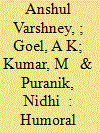| Srl | Item |
| 1 |
ID:
107480


|
|
|
|
|
| Publication |
2011.
|
| Summary/Abstract |
An urban wide-area recovery and restoration effort following a large-scale biological release will require extensive resources and tax the capabilities of government authorities. Further, the number of private decontamination contractors available may not be sufficient to respond to the needs. These resource limitations could create the need for decontamination by the building owner/occupant. This article provides owners/occupants with a simple method to decontaminate a building or area following a wide-area release of Bacillus anthracis using liquid sporicidal decontamination materials, such as pH-amended bleach or activated peroxide; simple application devices; and high-efficiency particulate air-filtered vacuums. Owner/occupant decontamination would be recommended only after those charged with overseeing decontamination-the Unified Command/Incident Command-identify buildings and areas appropriate for owner/occupant decontamination based on modeling and environmental sampling and conduct health and safety training for cleanup workers.
|
|
|
|
|
|
|
|
|
|
|
|
|
|
|
|
| 2 |
ID:
149011


|
|
|
|
|
| Summary/Abstract |
Anthrax, caused by Bacillus anthracis is known to occur globally since antiquity. Besides being an important biothreat agent, it is an important public health importance pathogen also in countries like India. B. anthracis secretes three distinct toxins, namely protective antigen (PA), lethal factor (LF) and edema factor (EF). PA is the central moiety of the anthrax toxin complex and therefore has been a molecule of choice for vaccine development. PA has four different domains with different functions. In this study, the major domains of PA were cloned and expressed in bacterial system. The purified recombinant proteins were used to determine the humoral immune response by ELISA using 43 human cutaneous anthrax serum samples. The maximum immunoreactivity was observed with the whole PA protein followed by domain 2, 4 and 1. The study corroborated that in addition to full PA, individual domain 2 and 4 can also be good target for vaccine development as well as for serodiagnostic assays for cutaneous anthrax
|
|
|
|
|
|
|
|
|
|
|
|
|
|
|
|
| 3 |
ID:
107476


|
|
|
|
|
| Publication |
2011.
|
| Summary/Abstract |
Consequence management following a release of aerosolized Bacillus anthracis spores requires a high level of technical understanding and direction. National policies and regulations address the topics of preparedness goals and organizational structure, but they do not tell responders how to perform remediation. Essential considerations include determining what must be cleaned, evaluating health risks, ascertaining the priority of cleanup, and selecting appropriate decontamination technologies to meet consensus and risk-derived clearance goals. This article highlights key features of a national-level framework that has been developed to guide a risk-based decision process and inform technical personnel of the best practices to follow during each activity leading to the restoration of functions at affected facilities or areas. The framework and associated guidance follows the scheme of 6 phases for response and recovery arrived at through interagency consensus and approval. Each phase is elaborated in a series of detailed decision flowcharts identifying key questions that must be addressed and answered from the time that first indications of a credible biological attack are received to final reoccupancy of affected areas and a return to normal daily functions.
|
|
|
|
|
|
|
|
|
|
|
|
|
|
|
|